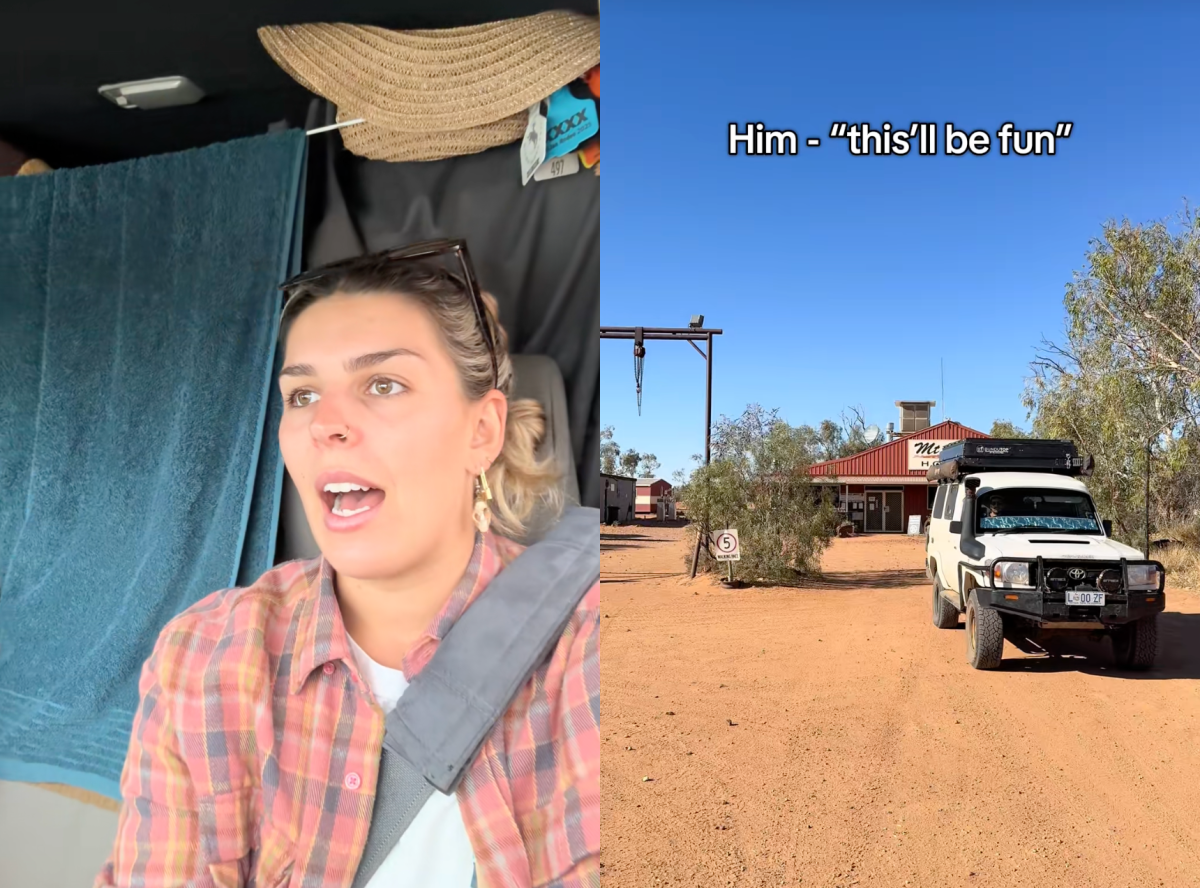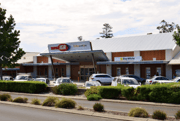
When Kira Maass glanced in her rear-view mirror during a drive towards Yulara last month, what she saw made her blood run cold.
A vehicle was sitting so close behind their Land Cruiser that she could barely see its bonnet—and it stayed there for a nerve-wracking 20 kilometres.
The driver wasn't just being aggressive or impatient. They were attempting a dangerous practice called 'slipstreaming' in a misguided attempt to save fuel. But on Australia's unforgiving outback roads, this risky manoeuvre could turn a family holiday into a tragedy.
A terrifying 20-kilometre ordeal
Kira and her partner Mitch Edwards, originally from Tasmania, have been travelling around Australia since January. They were making their way towards the iconic Uluru region in the Northern Territory when the incident unfolded on a stretch of remote highway.
'We were just travelling along at 90km per hour and Mitch pointed him out... I could only just see the corner of his van and he stayed there for ages,' Kira told Yahoo News. The dangerous dance continued for 15 minutes, with the trailing driver moving into the centre of the road as if to overtake, then pulling back without passing.
'The last thing we want is to have to stomp on the brakes and the person behind us be caught up in the problem as well'
The behaviour was so erratic that other motorists became involved. 'There was another vehicle travelling behind him at one point too. It could have been a really dangerous situation,' Kira explained.
When the driver finally overtook them and sped ahead, Kira and Mitch found themselves cheering with relief. The irony? 'We ended up at the same caravan park roughly the same time anyway, which made us laugh,' she said.
What is slipstreaming and why doesn't it work for regular cars?
Slipstreaming, also known as drafting, involves driving extremely close behind another vehicle to reduce wind resistance and theoretically save fuel. The technique works on the principle that the lead vehicle cuts through the air, creating a low-pressure zone behind it where the following vehicle faces less aerodynamic drag.
Professional racing drivers use this technique on closed circuits, and it can work behind large trucks on highways. However, attempting it behind a regular passenger vehicle is not only dangerous but largely pointless.
'Slipstreaming is a thing that a lot of people do with trucks... But we weren't much bigger than him. He would have had to have been much closer, almost touching our rear bar, to achieve slipstream,' Kira observed, highlighting the flawed logic of the dangerous driver's strategy.
The science behind slipstreaming
For slipstreaming to be effective behind a regular car, you'd need to drive dangerously close—within 1-2 metres. Even then, fuel savings would be minimal (perhaps 2-5 per cent) and only at sustained highway speeds. The risk simply isn't worth the negligible benefit.
Why outback roads make this practice lethal
Australia's remote highways present unique dangers that make tailgating particularly risky. Unlike city driving, where traffic moves slowly and help is nearby, outback roads demand different safety considerations.
Wildlife is perhaps the biggest concern. Dawn and dusk driving hours coincide with peak activity periods for kangaroos, wallabies, wombats, and even camels. These animals can appear suddenly, forcing drivers to brake hard or swerve. If you're following too closely, you have no time to react safely.
'There's livestock on almost every road, and travelling in dawn to dusk, you've got wallabies and wildlife, or there could even be a bloody camel,' Kira warned. 'The last thing we want is to have to stomp on the brakes and come to a stop or swerve and the person behind us be caught up in the problem as well.'
The isolation factor compounds these risks. Mobile phone coverage is patchy or non-existent in many remote areas. If an accident occurs, help might be hours away. Emergency services face significant challenges reaching crash sites on remote highways, making accident prevention crucial.
The fuel cost factor driving dangerous behaviour
Understanding why drivers attempt such risky fuel-saving measures requires looking at Australia's current fuel costs. Recent data shows Australian fuel prices around $1.65 per litre nationally, with Northern Territory prices reaching up to $1.96 per litre [1] [2] - among the highest in the country.
For travellers covering thousands of kilometres on outback highways, these costs add up quickly. The situation has worsened due to exchange rate impacts, with the March 2025 quarter seeing the lowest AUD-USD exchange rate in over 20 years at 62.7 cents [3].
Smart fuel-saving alternatives for outback travel
- Maintain steady speeds between 80-90km/h for optimal fuel efficiency
- Use cruise control on long, flat stretches
- Plan routes to avoid unnecessary detours
- Keep tyres properly inflated
- Remove excess weight and roof racks when not needed
- Travel during cooler parts of the day to reduce air conditioning use
However, the minimal fuel savings from dangerous slipstreaming pale in comparison to the potential costs of an accident. Insurance companies may refuse to cover claims involving reckless driving, and the human cost of injury or death cannot be measured in dollars.
Legal consequences across Australia
While road rules vary between states and territories, tailgating carries significant penalties across most of Australia. However, the Northern Territory—where this incident occurred—presents an interesting legal gap.
Unlike other jurisdictions, the NT doesn't have specific tailgating penalties, though dangerous driving charges can still apply. Most other states impose fines ranging from $200-500 for following too closely, with potential licence point deductions.
Road authorities across Australia recommend the 'three-second rule' for safe following distances in dry conditions, extending to six seconds in wet or slippery conditions. This means you should be able to count 'one thousand and one, one thousand and two, one thousand and three' between when the vehicle ahead passes a landmark and when you pass the same point.
Safety tips for senior outback travellers
Outback driving requires different skills and awareness than city driving. For senior travellers exploring Australia's remote regions, these safety considerations are particularly important:
Before you travel:
- Ensure your vehicle is serviced and roadworthy
- Carry extra water, food, and basic tools
- Inform others of your travel plans and expected arrival times
- Check weather and road conditions
On the road:
- Travel during daylight hours when possible
- Take regular breaks every two hours
- Stay alert for wildlife, especially at dawn and dusk
- Maintain safe following distances regardless of other drivers' behaviour
- Don't attempt to 'educate' dangerous drivers—let them pass safely when possible
If someone is tailgating you:
- Don't speed up or brake suddenly
- Indicate early and pull over safely when possible to let them pass
- Avoid eye contact or gestures that might escalate the situation
- If you feel threatened, drive to the nearest town or police station
The bigger picture: road safety in remote Australia
This incident highlights broader concerns about road safety education and enforcement in remote areas. While major highways receive regular police patrols, vast stretches of outback road rely on driver responsibility and common sense.
The combination of long distances, fuel costs, and isolation can create pressure for risky decisions. However, no amount of fuel savings is worth the potential consequences of a high-speed collision on a remote highway.
As Kira and Mitch's experience demonstrates, dangerous driving behaviour affects everyone on the road. Their relief when the tailgating driver finally passed speaks to the stress and fear such behaviour creates for innocent motorists.
Did you know?
Did you know?
Emergency services in remote Australia can take 2-4 hours to reach accident scenes on some outback highways. The Royal Flying Doctor Service often provides the fastest response for serious accidents, but prevention remains the best strategy.
For Australia's growing number of grey nomads and senior travellers, understanding these risks isn't about avoiding adventure—it's about ensuring you can enjoy many more adventures safely.
The outback offers some of the world's most spectacular driving experiences, from the Red Centre to the Kimberley. But respect for the environment, the distances, and other road users is essential for everyone's safety and enjoyment.
Have you encountered dangerous driving behaviour on outback roads during your travels? Share your experiences and safety tips in the comments below—your story could help keep fellow travellers safe.
Primary Source
https://au.news.yahoo.com/drivers-w...aving-hack-along-outback-roads-045834234.html
Australia gasoline prices, 13-Oct-2025 | GlobalPetrolPrices.com
Cited text: The current gasoline price in Australia is AUD 1.65 per liter or USD 1.07 per liter and was updated on 13-Oct-2025.
Excerpt: Recent data shows Australian fuel prices around $1.65 per litre nationally, with Northern Territory prices reaching up to $1.96 per litre
https://www.globalpetrolprices.com/Australia/gasoline_prices/
Fuel Cost Statistics in Australia—Road Genius
Cited text: State-level fuel prices vary with petrol prices ranging from AUD 178.0 cpl in Western Australia to AUD 195.8 cpl in the Northern Territory on average ...
Excerpt: Recent data shows Australian fuel prices around $1.65 per litre nationally, with Northern Territory prices reaching up to $1.96 per litre
https://roadgenius.com.au/statistics/fuel-cost-australia/
Average retail petrol prices edge higher in the March quarter on the back of a lower Australian dollar | ACCC
Cited text: Higher retail petrol prices on average largely reflected the impact of a lower AUD-USD exchange rate, which makes the international cost of refined pe...
Excerpt: The situation has worsened due to exchange rate impacts, with the March 2025 quarter seeing the lowest AUD-USD exchange rate in over 20 years at 62.7 cents
https://www.accc.gov.au/media-relea...rter-on-the-back-of-a-lower-australian-dollar







